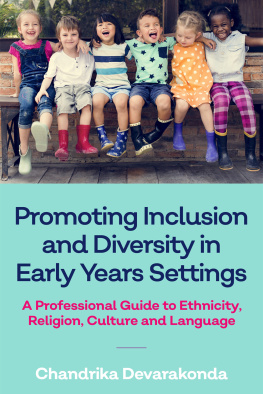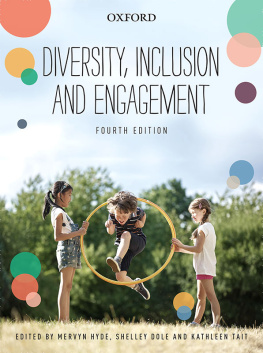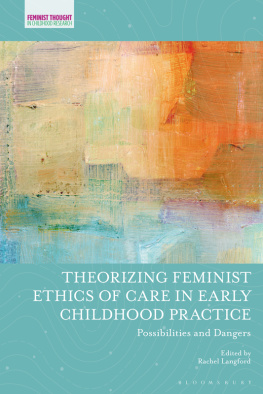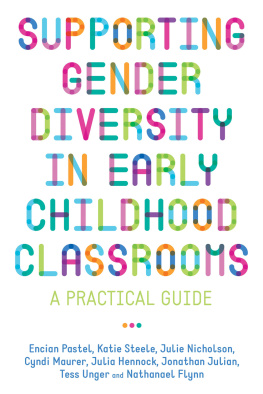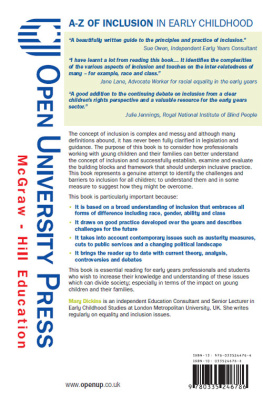DIVERSITY &
INCLUSION
IN EARLY
CHILDHOOD
Education at SAGE
SAGE is a leading international publisher of journals, books, and electronic media for academic, educational, and professional markets.
Our education publishing includes:
- accessible and comprehensive texts for aspiring education professionals and practitioners looking to further their careers through continuing professional development
- inspirational advice and guidance for the classroom
- authoritative state of the art reference from the leading authors in the field
Find out more at: www.sagepub.co.uk/education

DIVERSITY &
INCLUSION
IN EARLY
CHILDHOOD
An Introduction

CHANDRIKA DEVARAKONDA


SAGE Publications Ltd
1 Olivers Yard
55 City Road
London EC1Y 1SP
SAGE Publications Inc.
2455 Teller Road
Thousand Oaks, California 91320
SAGE Publications India Pvt Ltd
B 1/I 1 Mohan Cooperative Industrial Area
Mathura Road
New Delhi 110 044
SAGE Publications Asia-Pacific Pte Ltd
3 Church Street
#10-04 Samsung Hub
Singapore 049483
Commissioning editor: Jude Bowen
Editorial assistant: Miriam Davey
Project manager: Jeanette Graham
Assistant production editor: Thea Watson
Copyeditor: Carol Lucas
Proofreader: Isabel Kirkwood
Marketing manager: Lorna Patkai
Cover design: Wendy Scott
Typeset by: Dorwyn, Somerset, UK
Printed by: CPI Group (UK) Ltd., Croydon,
CRO 4YY
Printed on paper from sustainable resources

Chandrika Devarakonda, 2013
First published 2013
Apart from any fair dealing for the purposes of research or private study, or criticism or review, as permitted under the Copyright, Designs and Patents Act 1988, this publication may be reproduced, stored or transmitted in any form, or by any means, only with the prior permission in writing of the publishers, or in the case of reprographic reproduction, in accordance with the terms of licences issued by the Copyright Licensing Agency. Enquiries concerning reproduction outside those terms should be sent to the publishers.
Library of Congress Control Number: 2012937787
British Library Cataloguing in
Publication data
A catalogue record for this book is available from the British Library
ISBN 978-0-85702-850-1
ISBN 978-0-85702-851-8 (pbk)
Contents
Let us pray
Dear god
We thank you in many different ways
And thank you for making us all different
If we were not varied, our lives would be plain boring
It does not matter where people come from or what religion they are
We should treat everyone equally, and not leave them out, just because they are
Different from us
Help us to appreciate every one, and how they are
Amen
By Anuradha Ponnapalli
7 years
This poem illustrates how children are inclusive and open. Although they do recognise the differences, they are happy to accept these unconditionally. They are, however, influenced by their families, peer group, practitioners and teachers from settings such as early childhood settings and schools.
This poem shows how positive experiences will enable young children to embrace diversity from a young age. This book will attempt to explore several issues around inclusion from the perspective of children, parents and practitioners.
List of figures and tables
Figures
Tables
About the author
Chandrika Devarakonda is a senior lecturer at University of Chester, UK. Her background in child development and her passion for inclusion have influenced her teaching and research interests. Her research interests lie in inclusion, childrens rights, diversity and international perspectives of early childhood education. She has worked in a further education (FE) college in Manchester for 10 years teaching early childhood and health and social care courses. She has worked with disabled children in different settings, including special schools, and in community-based rehabilitation centres in India.
Acknowledgements
I would like to express my sincere gratitude to the following people who have influenced me and supported me.
I would like to thank my mother and father for being my inspiration and instilling in me good values and being my first educators. I would not have achieved much without your words of wisdom.
I would like to express my thanks to my father- and mother-in-law for being kind and supportive. My husband, Prasad, has been my pillar of strength and provided moral support. My daughter Anuradha has kept me in good cheer and enabled me to understand the concept of inclusion by sharing her experiences in the early childhood settings. All my brothers- and sisters-in-law have constantly encouraged me in this endeavour.
Professor Jeyachandran and Mrs and Mr Ramaswami have been responsible for tapping my potential, Professor Peter Farrell and Professor Peter Clough for sowing seeds of confidence and believing in me.
Thanks to my friends: Barbara Oxley for reading and commenting on my draft chapters promptly, Frances Atherton for her constant support, and Kate Wilkinson who has been inspirational and who is sadly missed. Karen Turner for all the discussions we had about inclusion and all my students on the Early Childhood Studies courses at undergraduate and postgraduate levels, who actively participated in discussions and shared their perceptions of inclusion. In addition, they constantly reminded me of the lack of a book that covered inclusion from a wider perspective that sparked the idea for this book.
I am grateful to Sage Publications, especially Jude Bowen for her enthusiasm and positive belief, sharing my vision of the book and being a constant source of encouragement, as well as Amy, Alex, Miriam, Jeanette and others for their patience and support through the whole process. I appreciate the constructive comments on the book proposal as well as draft chapters from reviewers. I would like to express my thanks to all the authors who gave permission to use their valuable work.
I would like to take this opportunity to thank everybody for making this dream come true.
Introduction
What is inclusion?
Inclusion is an elusive concept in spite of several definitions from experts, organisations and countries as well as other individuals. These definitions addressed a host of issues. Inclusion is a concept that is relevant in all countries around the world. However, the concept is interpreted in a wide range of ways. The basis for the differences is not consistent and it seems to have evolved over time.
The concept of inclusion has been defined particularly in reference to special educational needs (SEN). Ainscow (1999) argued that inclusion relates to more than children with SEN and disabilities, and is an ongoing process that does not stop at any stage. Some other definitions relate to the whole community, or to a philosophical stance linking to ethical values and beliefs.
Next page

